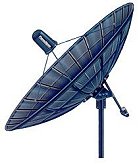An LNB, or Low Noise Block, is an amplifier which receives the radio signal from the satellite after it has been reflected by the satellite dish.
In addition to amplifying the signal, the LNB also converts the signal to a frequency usable by the In-Door-Unit.
The functions of the LNB were at one time provided by two separate components, a Low Noise Amplifier (LNA) for signal amplification and a block downconverter for downconversion.
Most LNB's used for satellite television include an integrated feedhorn. An LNB with an integrated feedhorn is known an an LNBF.
C Band LNB's are measured in degrees Kelvin, with a lower number representing a higher grade LNB. Ku and Ka band LNB's are measured in decibels, with a lower number also representing a higher quality LNB.
Dual and Quad LNB Units
A Dual LNB will allow you tune into two separate satellite signals at once. This is very useful if you have two television sets and wish to watch different channels on each of them. Quad-LNB's also exist for those with more than two television sets.
What is a feedhorn?
The feedhorn is the part of a satellite dish system which gathers the reflected signal from the dish and focuses it towards the LNB.
An LNB with an integrated feedhorn is referred to an an LNBF.
--------------------------------------------------------------------------------------
C Band
C band is the original frequency allocation for communications satellites.
C-Band uses 3.7-4.2Ghz for downlink and 5.925-6.425Ghz for uplink.
The lower frequencies used by C band perform better under adverse weather conditions than the Ku band or Ka band frequencies.
C Band Dishes
C band requires the use of a large dish, usually 6' across. C band dishes vary between 3' and 9' across, depending upon signal strength.
Because C Band dishes are so much larger than Ku and Ka band dishes, a C Band dish is sometimes referred to in friendly jest as a BUD (Big Ugly Dish).

--------------------------------------------------------------------------------------
Ku band
The Ku band uplink uses frequencies from 14 to 14.5GHz and the downlink uses frequencies between 11.7 and 12.7GHz.
The Ku band downlink frequencies are further subdivided according to their assigned use:
Ku Band Usage Downlink Fixed Satellite Service 11.7 - 12.2Ghz Broadcast Satellite Service 12.2 - 12.7GhzThe higher frequencies of Ku band are significantly more vulnerable to signal quality problems caused by rainfall, known as rainfade, than C band satellite frequencies. However, they are less susceptible to rainfade than the Ka band frequencies.
Ku band satellites typically transmit with much more power than C band satellites. This allows Ku band dishes to be smaller and helps Ku band transmissions to overcome rainfade.
Ku Band Dishes
Ku band dishes can be much smaller than C band dishes. Ku band dishes vary from 2' to 5' in diameter.
Using a C Band Antenna for Ku Band
It is possible to add a Ku Band LNB to a C Band satellite dish.
For this to work properly, the C Band dish must be a solid dish or a mesh dish with holes less than one-quarter inch across.

--------------------------------------------------------------------------------------
Ka band
The Ka band uplink uses frequencies between 27.5Ghz and 31Ghz and the downlink uses frequencies between 18.3 and 18.8Ghz and between 19.7 and 20.2Ghz.
Ka band dishes can be much smaller than C band dishes. Ka band dishes vary from 2' to 5' in diameter.
Ka band satellites typically transmit with much more power than C band satellites.
The higher frequencies of Ka band are significantly more vulnerable to signal quality problems caused by rainfall, known as rainfade

--------------------------------------------------------------------------------------
No comments:
Post a Comment